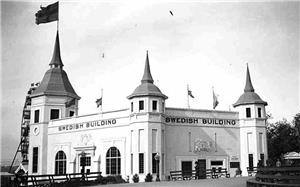Before the great fire of June 6, 1889, Seattle's Swedish population was small. The census of 1880 counted only 190 people of Scandinavian heritage in all of King County. A tremendous influx took place between 1890 and 1910, when close to 150,000 Scandinavians settled in the Pacific Northwest, thus making them the largest foreign-born ethnic group in the state. Swedes worked in the woods around Preston and High Point, in the Ballard mills, on the railroads building tunnels and laying tracks, in construction (contributing both labor and architectural skills), in the mines at Coal Creek, on the docks on Seattle's waterfront, and as farmers around King County.
By 1910, Scandinavians in Seattle numbered 19,046, 31.3 percent of the foreign born, and of these 8,678 were Swedes. By 1920, Swedes had grown to 10,253 decreasing slightly to 9,634 in 1930.
The Early Years
Between 1890 and 1930, a large number of Swedish organizations both secular and religious flourished, and many Swedish-owned businesses were established. The early Swedes flocked together, creating an extremely varied array of clubs, singing societies, lodges, orders, churches, and newspapers. These organizations served an important function in almost every aspect of life whether social, spiritual, or charitable.
Swedish Club (now renamed Swedish Cultural Center) was founded in 1892 by newly arrived Swedes who lived at the Stockholm Hotel located at 1st Avenue and Bell Street. The hotel, which also housed the local Swedish newspaper, Svenska Pressen and a restaurant, was owned and operated by financier Andrew Chilberg, President of the Scandinavian-American Bank and Puget Sound Savings and Loan Company, city treasurer, and consul of Sweden.
Many founders and early members of the Swedish Club became successful business people in Seattle such as Nels B. Nelson of Frederick & Nelson; John Edward Chilberg, financier and later president of the Alaska-Yukon-Pacific Exposition of 1909; and John Nordstrom who together with Carl Wallin started what today is one of America's largest department stores.
Swedish Hospital
One of the Club's concerns was the health care of the Swedes in the area and when Svenska Lasarettet (Swedish Hospital) was organized in June 1908, nearly all the men signing the papers of incorporation were members of the club including Otto Roseleaf, P. A. Hallberg, J. A. Soderberg (1866-1935), John Kalberg, Godfrey Chealander (1868-1953), N. J. Nyquist, Emil Lovegren, Israel Nelson, Gustaf Axel Edelsvard, H. E. Turner, and Dr. Nils A. Johanson, the main driving force behind the hospital.
The hospital opened in 1910 in a leased building on 1733 Belmont Avenue, moving to a new building on Summit and Columbia in 1912. Today Swedish Hospital Medical Center is an internationally recognized multi-specialty medical center and contains several campuses. It is the largest health care facility in the Pacific Northwest and the dreams of the first-generation Swedes have indeed paid off -- the hospital has not only played an important part in the city's Scandinavian history but in the lives of everyone in the Northwest.
The Church
The church was an important factor in the life of the immigrants both socially and spiritually. The major denominations among King County Swedes were Lutheran, Baptist, Methodist, and Christian Mission Friends, which later changed its name to Covenant Church. In Seattle, the Swedish Gethsemane Lutheran congregation was formed in 1885 by Reverend Peter Carlson who had been called by the Augustana Synod to carry out work among the Swedes on the West Coast. The present church is located on 9th Avenue. The Swedish Baptist Church was initially located at 8th Avenue and Bell Street, and then moved several times until a church was built on 9th Avenue and Pine Street.
Especially noteworthy was the 30-year pastorate of the Reverend Doctor Emil Friborg who was also instrumental in the founding of Adelphia College in 1905. One of the College's benefactors, August Lovegren, associated with the Preston Saw Mill, along with C.J. Erickson, a prominent businessman, contributed money and property to enable the construction of Adelphia Hall. The property was later sold to Seattle Preparatory School. The First Covenant Church located at Pike and Bellevue has its origin in the Swedish Christian Mission Congregation begun in 1888 and established as a congregation in February of 1889.
Other organizations with Swedish origin are the Lutheran Compass Mission whose driving force, Pastor Otto R. Karlstrom, acutely felt the need to help the homeless. The Millionair Club is another example of social concern among the Swedes. Launched by Martin Johanson in 1921 the institution is based on the idea of self-help, providing food, clothing, and a temporary job for the homeless. It still serves the same purpose today at its location on Western Avenue in downtown Seattle.
Education and Culture
The Scandinavian Department at the University of Washington was established in 1909 when the influx of Scandinavian immigrants to the Northwest was at its height. Its origin goes back to the time when a Swedish-American judge, Gustav Bonde, sponsored an addition to the State Constitution, requiring a program in Swedish language to be part of the University's course offerings. Today it is the largest Scandinavian Department in the United States.
Swedish social organizations include numerous Vasa Lodges; several folk dance and music groups such as Skandia Folkdance Society, which began its activities in 1949; the Swedish Cultural Society, founded in 1921; the North Star Lodge of the International Order of Good Templars that still keeps a summer camp on Mercer Island; and a relative newcomer, SWEA Seattle -- Swedish Women's Educational Association, which carries on all meetings in the Swedish language.
Nordic Heritage
Also a relative newcomer is the Nordic Heritage Museum, founded in November 1979, whose mission it is to document and preserve the Swedish history in King County and the region. Today's Swedish immigrants, highly educated with a global outlook, are few in numbers. They are no longer clustered in specific areas but they continue to contribute to Swedish-American life in Seattle and King County and to keep an active dialogue with contemporary Sweden.

